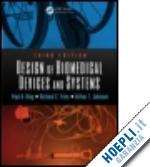Paul King, PhD, PE, attended Case Institute of Technology for his BS and MS and then obtained his PhD at Vanderbilt University in 1968 (mechanical engineering.) That same year, he became one of the founding members of the Department of Biomedical Engineering at Vanderbilt University. He developed and taught most of the early required coursework in the Department of Biomedical Engineering. In approximately 2001 he and coauthor Richard Fries published the first edition of the textbook Design of Biomedical Devices and Systems. This textbook is being used in multiple universities in the United States and abroad. Richard Fries, PE, CSQE, CRE, is a licensed professional engineer in the state of Wisconsin and certified by the American Society for Quality as a reliability engineer and a software quality engineer. He has degrees from Loyola University in Chicago and Marquette University in Milwaukee. He is co-inventor of patent 5,682,876, entitled "absorber switch locking device." He has authored eight books and chapters in several others on reliability and regulatory compliance. He has also written numerous articles in professional journals on hardware and software reliability, human factors, standards and regulations, and engineering education. Arthur T. Johnson attended Cornell University for his undergraduate and graduate degrees. His PhD was awarded in 1969. He joined the faculty of the University of Maryland in 1975 and was professor from 1986 until 2009, when he became professor emeritus. He has written three books: Biomechanics and Exercise Physiology, Biological Process Engineering, and Biology for Engineers. He has been most recently active in teaching electronic design, transport processes, and engineering in biology courses, and in working to continue development of the airflow perturbation device as a noninvasive measurement of respiratory resistance.












